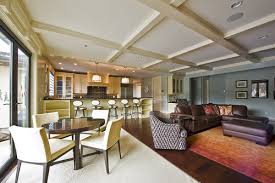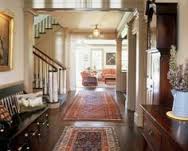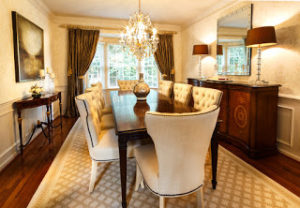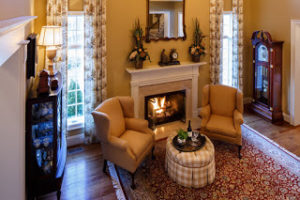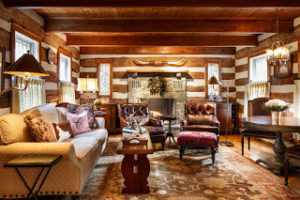When working on a design project, I am often asked, “Do we start with the rug or end with the rug?” My answer is “It depends.” If you have a rug that you love, that is a great place to start. If not, I usually prefer to select the rug later in the project.
If you are planning to purchase a rug for your design project, it is best to have an idea of the types of rugs that are available to you before making the investment. Here are a few of the major types of rugs you might consider and why:
Hand Knotted
Hand knotted rugs take the most time to make, because they are hand woven and knotted by highly skilled artisans. The rug quality can be determined by the number of knots per square inch — the higher the density, the higher the quality. Each hand knotted rug is literally one of a kind, they tend to be more expensive and have longer lead times. A custom hand knotted rug can take 6 – 9 months to produce.
Broadloom
A broadloom rug is something we often use in design. They are rugs made from regular solid or patterned carpeting, which are then cut and custom bound for a specific space. Custom borders can be added to make it even more unique. These rugs are very affordable (especially for large spaces) since they are based on high volume carpeting, but can still be very high quality and they don’t have long lead times! These rugs are perfect for high use rooms such as a large family room or dining area.
Flat Weave
Flat weave rugs are light, reversible and lay, well…flat. They can be very durable, are not very expensive and easy to roll up and move. They tend to have a less formal feel, and are great in more casual settings. A good non-slip pad is a must with a flat weave rug as they slide easily.
Machine Made
Machine made rugs are made on a loom that is powered by a computer or machine. These rugs are produced quickly and are often called “production” rugs. They can be part of a series of rugs that offered in a specific pattern with the option of different color ways and sizes.
There is nothing wrong with machine made rugs, but it is important to understand what you are buying. Machine made rugs can easily be confused with higher quality, hand knotted rugs. If you don’t know the difference, you can accidentally overpay for a machine made rug.
Indoor/Outdoor
These rugs are generally made from Olefin, polypropylene, or other man made fibers. Indoor/outdoor rugs often have texture, color and pattern. They are great for use indoors in high traffic areas. They can be colorful and have lots of patterns. As a rule they are fairly inexpensive.
Hand Tufted
Hand tufted rugs are made with a tufting gun. The rug is made using a pre-constructed form (think of a needlepoint or cross stitch fabric) and the yarn is hooked and pulled through the surface. The backs of these rugs are usually coated with vinyl or cotton to help the rug maintain its shape. Most hand-tufted rugs are wool and generally moderately priced.
Antique Rugs
Antique rugs are well worn, well loved and have a story to tell. They can be found in auction houses, antique stores or in your grandmother’s attic. They can be more expensive, more delicate, and must be treated with care (like anything old!). Antique rugs are unique, pieces of art.
After the type of rug has been decided, you might consider a few of the following “pearls” regarding how to select, care and enjoy your rug for years and years…
Rugs Don’t Have to Match!
For me, rugs are artwork for the floor. They are a key element in a well-designed room and should be selected with thought and care. However, like artwork, your rugs don’t have to match!
Set the Mood.
When choosing a rug, consider your intention for the rug. Do you want the rug to make a statement or be a restful backdrop to the overall design? The style of a rug can significantly impact a room. If you want the rug to take center stage, then go for a big geometric or floral pattern. If your goal is to make the room feel restful and sophisticated, keep the rug simple and tonal in palette.
Color.
Bright, bold colors lend a feeling of energy and excitement, while tonal neutral colors feel calm and restful. Earthy tones can make a room feel grounded and cool tones such as blues can feel relaxing and serene.
Getting the Size Right.
There are no hard and fast rules about how to size a rug to fit your space, but a good practice is to decide if the rug is going to fill the whole room or define a space within the room.
When filling the space, I usually measure 12-15 inches off each wall to determine the overall rug size. Of course, you have to consider floor vents, traffic patterns and door swings into this equation, but it is a good, general guide to help you determine the size you need. Room size area rugs, particularly simple or solid rugs, tend to “push the walls out” and make the room feel larger.
Smaller rugs can be used to define traffic patterns, conversation settings or dining areas. Don’t worry about all the furniture being on or off the rug. It is totally acceptable to have some of the pieces both on and off the rug in a furniture setting.
Runners or narrow rugs are perfect for outlining a pattern for traffic flow.
The above photos are from SCL Design Projects
Don’t Forget the Rug Pads.
A good quality rug pad to essential to the durability and safety of your rug. Like most things in life, foundation is key! There are several types of pads to choose from and vary depending on the floor the rug will cover. Some pads are suitable for a “rug-on-carpet” application, but most are intended for rugs to be on a smooth surface such as wood or tile.
It is important that your rug stay put and not slip. Rug pads are designed to prevent slipping, but come in degrees of holding power. Also, some pads offer fiber padding for the added benefits of cushion and insulation. These pads are thicker and can change the profile of the rug. It is important to trim these types of pads 1″ – 2″ from the border of the rug to prevent tripping.
Consider your needs and choose the pad accordingly.
Choose the Right Vacuum.
Different types of rugs require different types of vacuums. Nothing is more disheartening than seeing a beautiful, hand knotted masterpiece ruined by a powerful, beater bar vacuum. Most high-end vacuums have multiple settings and are designed to work with different types of rugs. Invest in a quality vacuum — it will more than pay for itself in the long run by extending the life and beauty of your rugs.
Whether you start or finish with the rug, I hope these few basic tips help you select the perfect rug to fit your needs and enhance your space. Happy hunting!







